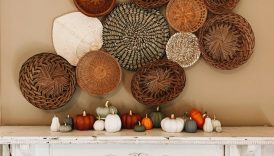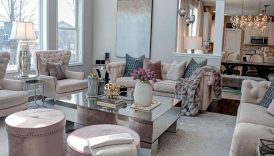Eco-Friendly Interior Design Solutions for a Sustainable Home

Importance of Eco-Friendly Interior Design
In an age where environmental issues are increasingly coming to the forefront, eco-friendly interior design stands out as a critical focus for homeowners and designers alike. The push for sustainability is not merely a trend; it reflects a deep-rooted desire to harmonize our living spaces with the earth. By embracing eco-friendly practices in interior design, individuals can contribute to a healthier planet while also creating a serene environment in their homes. Consider, for instance, a family that recently renovated their living space. They opted for sustainable materials and energy-efficient appliances, significantly reducing their carbon footprint. Not only did they enjoy the aesthetic benefits of their beautifully designed home, but they also felt a sense of accomplishment knowing they were making mindful choices for the environment.
- Eco-Friendly Interior Design Solutions for a Sustainable Home
- Importance of Eco-Friendly Interior Design
- Benefits of Sustainable Home Decor
- Sustainable Materials for Interior Design
- Bamboo and Cork
- Recycled Glass and Reclaimed Wood
- Energy-Efficient Lighting Options
- LED Lighting Technology
- Natural Light Optimization Techniques
- Indoor Air Quality Improvement
- Use of Non-Toxic Paints
- Incorporating Plants for Air Purification
- Water Conservation Strategies
- Low-Flow Plumbing Fixtures
- Greywater Recycling Systems
Benefits of Sustainable Home Decor
Choosing sustainable home decor goes far beyond aesthetics. It presents numerous benefits that can enhance the well-being of the occupants and the surrounding environment. Here are some compelling reasons to embrace this approach:
- Healthier Living Environment: Eco-friendly materials often lead to improved indoor air quality, reducing exposure to harmful chemicals and toxins. Families, particularly those with young children or allergies, find that sustainable choices lead to fewer health issues.
- Cost Savings: While the initial investment in eco-friendly materials might be higher, they often pay off in the long run through reduced energy bills and maintenance costs. For example, energy-efficient appliances can lead to significant savings over time.
- Durability and Quality: Sustainable materials like bamboo or reclaimed wood are not only attractive but also more durable than conventional options. Homeowners often find that these materials stand the test of time, requiring fewer replacements and renovations.
- Personal Satisfaction: Creating a space that reflects one’s values can lead to immense personal satisfaction. People often take pride in knowing they are contributing to a sustainable future, creating a more fulfilling living experience.
By integrating eco-friendly practices into their decor, individuals can transform their homes into sanctuaries that are both beautiful and responsible. As we move forward in this series, we will explore various elements of sustainable interior design, unearthing practices and materials that make a real difference.
Sustainable Materials for Interior Design
Bamboo and Cork
As we delve deeper into the realm of sustainable materials, bamboo and cork emerge as two highly versatile and eco-friendly options that have gained popularity among homeowners and designers alike. Bamboo, often seen as a modern alternative to traditional hardwood, is a rapidly renewable resource. It grows at an astonishing rate of up to three feet a day, making it one of the most sustainable materials on the planet. Imagine a chic bamboo floor in your living room that not only looks elegant but also boasts numerous environmental benefits, such as:
- Strength and Durability: Bamboo is incredibly sturdy and has a natural resistance to moisture and insects.
- Biodegradable: At the end of its life cycle, bamboo can break down naturally, minimizing landfill waste.
On the other hand, cork is harvested from the bark of cork oaks without harming the trees, allowing them to continue growing and absorbing carbon dioxide. This charm makes cork an attractive choice for flooring, wall coverings, and even furniture. Some of its notable qualities include:
- Thermal and Acoustic Insulation: Cork naturally regulates temperature and reduces noise, making it perfect for cozy interiors.
- Natural Fire Resistance: It has a unique ability to withstand fire, adding an extra layer of safety to your home.
Recycled Glass and Reclaimed Wood
In the pursuit of sustainable materials, recycled glass and reclaimed wood have become indispensable in eco-conscious design. Recycled glass can be transformed into stunning countertops, stunning mosaics, or beautiful decorative pieces. Using recycled glass not only keeps waste out of landfills but also infuses your space with vivid colors and unique textures. Some benefits of incorporating recycled glass include:
- Customizability: The variety of colors and styles available allows for infinite design possibilities.
- Low Maintenance: This material is resistant to stains and will retain its vibrant look for years.
Reclaimed wood adds a sense of warmth and history to any space. Sourced from old barns, factories, and warehouses, this wood brings a unique story and character to your home. By choosing reclaimed wood, homeowners can benefit from:
- Less Environmental Impact: Utilizing existing materials reduces the demand for new lumber, preserving forests.
- Aesthetic Appeal: Each piece of reclaimed wood is unique, contributing to a design that is truly one-of-a-kind.
Incorporating these sustainable materials not only enhances the aesthetic of your home but also aligns with the growing commitment to environmental stewardship. As we explore further, the discussion will continue around energy-efficient lighting options, keeping our focus on sustainable practices that make a lasting impact.
Energy-Efficient Lighting Options
LED Lighting Technology
Transitioning from sustainable materials, an equally crucial aspect of eco-friendly interior design is energy-efficient lighting. One of the standout heroes in this category is LED (Light Emitting Diode) lighting technology. Over the years, LEDs have gained traction for their efficiency and longevity, making them a favorite among homeowners. Imagine a cozy evening at home with warm LED lights casting a gentle glow over your living space. Not only does this create a welcoming atmosphere, but it also dramatically reduces energy consumption. Here are some compelling reasons to consider LED lighting for your home:
- Energy Savings: LEDs use up to 75% less energy than traditional incandescent bulbs, leading to significant savings on your electricity bill.
- Longevity: An LED bulb can last up to 25,000 hours compared to just 1,000 hours for incandescents, reducing the frequency of replacements.
- Variety of Options: From soft white to vibrant colors, LED lights come in various intensities and hues, allowing for customization to match your decor style.
When a friend of mine switched to LED lighting, they were astonished by the transformation in both the ambiance and their electricity bill. It was a simple change with a striking impact!
Natural Light Optimization Techniques
In addition to installing LED lighting, leveraging natural light is another effective strategy to enhance energy efficiency in your home. Optimizing natural light not only reduces reliance on artificial lighting but also creates a lively and cheerful environment. Here are practical tips for maximizing natural light:
- Strategic Window Placement: Ensuring that windows are appropriately placed can significantly increase sunlight exposure throughout the day.
- Use of Mirrors: Placing mirrors opposite windows can reflect light deeper into the room, enhancing brightness without additional energy use.
- Light-Colored Walls and Decor: Utilizing light-colored paint and furnishings helps to reflect light rather than absorb it, contributing to a brighter space.
A personal experiment in my own home illustrated the power of natural light. By simply rearranging furniture and adding strategically placed mirrors, the living room went from dull and dark to vibrant and open, all while reducing the need for artificial lighting during the day. By embracing energy-efficient lighting options, such as LED technology and optimizing natural light, homeowners can create inviting spaces while significantly cutting energy costs. In the next section, we will delve into the importance of indoor air quality improvement and how to achieve it through mindful choices.
Indoor Air Quality Improvement
Use of Non-Toxic Paints
Continuing our exploration of sustainable interior design practices, a crucial but often overlooked aspect is indoor air quality improvement. Utilizing non-toxic paints is one significant approach to enhance the air quality in our homes. Traditional paints emit volatile organic compounds (VOCs) that can linger in the air, leading to headaches, respiratory issues, and other health concerns. Making the switch to non-toxic paints can dramatically enhance your indoor environment. Imagine freshly painted walls with a pleasant smell rather than the harsh chemical scent that often accompanies standard paint. Here are some reasons to consider using non-toxic paints:
- Health Benefits: Non-toxic paints are free from harmful chemicals, providing a safer environment for your family, especially young children and pets.
- Low Odor: These paints have a far less intense smell, leading to a more pleasant painting experience and a quicker return to normal living conditions.
- Eco-Friendly Choices: Many non-toxic paints are made from natural, sustainable ingredients, ensuring a smaller environmental footprint.
A close friend of mine recently renovated her child’s bedroom and decided to go with a non-toxic paint. She noticed not only a reduction in odors but also a remarkable improvement in her child’s allergies. It was clear that choosing the right paint could make a real difference.
Incorporating Plants for Air Purification
Another effective strategy for improving indoor air quality is incorporating houseplants into your design. Not only do plants add beauty to your space, but they also work tirelessly to purify the air. They absorb toxins and release oxygen, creating a healthier atmosphere. Here are a few plants known for their air-purifying abilities:
- Spider Plant: Easy to care for and excellent at removing pollutants like formaldehyde.
- Snake Plant: Perfect for low-light areas, this plant converts CO2 into oxygen at night, promoting better sleep.
- Peace Lily: Known for its beautiful white blooms, it effectively removes ammonia and other harmful chemicals from the air.
When I added a few snake plants to my home office, I was pleasantly surprised by how much fresher the air felt. Plus, caring for them became a rewarding hobby! Incorporating non-toxic paints and introducing houseplants into your living spaces are two simple yet effective strategies to improve indoor air quality. By prioritizing clean air, you create a healthier home environment. Next, we will discuss water conservation strategies that can further enhance sustainability in your home design.
Water Conservation Strategies
Low-Flow Plumbing Fixtures
As we continue our journey toward sustainable living, it’s essential to discuss water conservation strategies—an often underappreciated aspect of eco-friendly design. One of the most effective ways to conserve water in your home is by installing low-flow plumbing fixtures. These fixtures do not compromise on performance while significantly reducing water consumption. Low-flow toilets, showerheads, and faucets utilize advanced technology to minimize water usage without sacrificing comfort or effectiveness. For instance, modern low-flow toilets can use as little as 1.28 gallons per flush, compared to older models that use up to 3.5 gallons. Here are some compelling reasons to consider upgrading:
- Cost Savings: With reduced water usage, homeowner can see a dramatic decrease in their water bill over time.
- Environmental Impact: Less water consumption helps to conserve vital resources, particularly in regions experiencing drought conditions.
- Better Performance: Many low-flow fixtures are now designed with efficiency in mind, ensuring excellent performance that keeps pace with traditional fixtures.
When my family remodeled our bathroom, we decided to install low-flow fixtures. It was astounding to see how much water we saved while enjoying all the comforts we had before.
Greywater Recycling Systems
In addition to low-flow fixtures, implementing a greywater recycling system can take your water conservation efforts to the next level. Greywater refers to gently used water from sinks, showers, and washing machines that can be recycled for non-potable uses, such as irrigation or toilet flushing. Here’s why greywater recycling is a smart choice for environmentally conscious homeowners:
- Resource Efficiency: Instead of discarding water that could be reused, greywater systems allow homeowners to repurpose it, reducing overall water consumption significantly.
- Garden Health: Using treated greywater for irrigation means more water for gardens and landscaping, promoting healthier outdoor spaces.
- Easy Installation Options: Various systems are available, from simple collection barrels to more advanced treatment systems that can be installed in new and existing homes.
After installing a greywater system for our garden, not only did our plants flourish, but we felt empowered knowing we were minimizing our environmental footprint. Incorporating low-flow plumbing fixtures and greywater recycling systems are just two impactful strategies for water conservation. As we embrace these methods, we contribute to a more sustainable future while enjoying the benefits of a responsible and beautiful living environment. In our following discussions, we will wrap up by summarizing key points and reflecting on the transition to eco-friendly practices in interior design.





